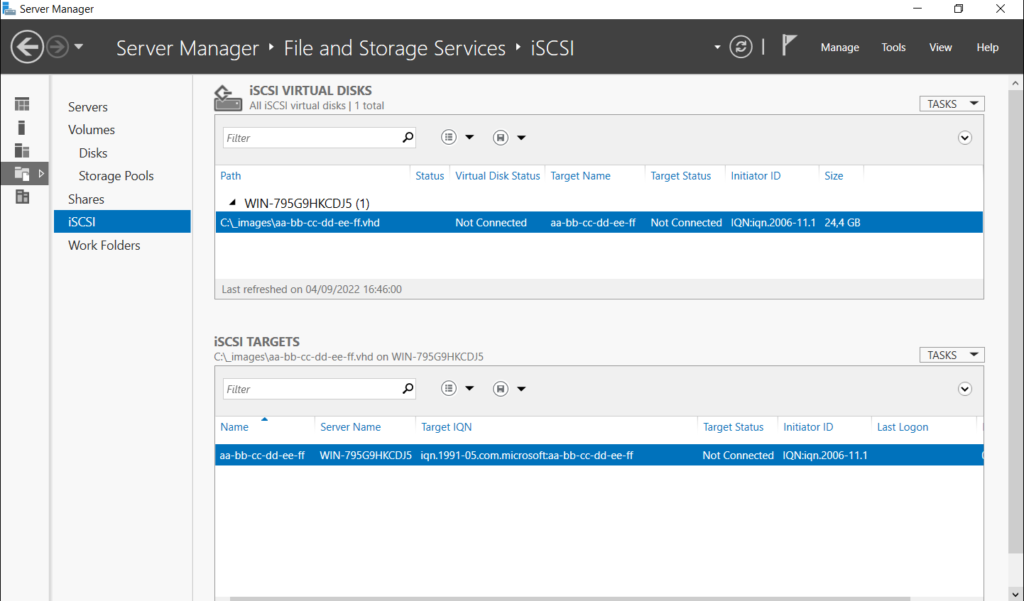A while ago, we have seen here how we could play with vhd differencing disks and starwind san free product.
However, the poor scripting capabilities of starwind san free associated with a strict licensing model renders this solution dodgy.
Today lets see how we achieve a better solution with powershell and windows iscsi target capabilities.
First lest have at the script below : all it does is create an iscsi target for the incoming requests if the target does not exist yet thus enabling one to boot many client devices from one unique parent/master.
Note : creating your master image (i.e a windows that can boot over the network using iscsi is not in scope here).
write-host "#!ipxe"
write-host "clear net0.dhcp/gateway:ipv4"
write-host "set gateway 0.0.0.0"
write-host "set initiator-iqn iqn.2006-11.1"
write-host "set keep-san 1"
#if pxesrv is running on the isci target, use ${next-server} instead of harcoded ip
write-host 'set target ${next-server}'
#
$TargetName = $args[0]
write-host "echo TargetName: "$TargetName
$vhdpath = "C:\_images\" + $args[0] + ".vhd"
write-host "echo vhdpath: "$vhdpath
$iqn ="iqn.1991-05.com.microsoft:"+$TargetName
write-host "echo iqn: "$iqn
if (-not(Test-Path -Path $vhdpath -PathType Leaf)) {
$parent = "c:\_images\iscsi.vhd"
#$result=New-VHD -ParentPath $parent -Path $vhdpath -Differencing -Confirm:$false
$result=c:\temp\vmount.exe createchildvhd $vhdpath $parent
$result=Import-IscsiVirtualDisk -Path $vhdpath
$result=New-IscsiServerTarget -TargetName $TargetName -InitiatorIds "iqn:iqn.2006-11.1"
#option : Set-IscsiServerTarget -TargetName "child1" -InitiatorId "IQN:*"
$result=Set-IscsiServerTarget -TargetName $TargetName -TargetIqn $iqn
$result=Add-IscsiVirtualDiskTargetMapping -TargetName $TargetName -DevicePath $vhdpath
write-host "echo iscsi target configured, enjoy !"
}
#
write-host $('sanboot --keep iscsi:${target}:tcp:3260:0:' + $iqn)
Lets first run tiny pxe server (as admin since we will be calling some low level powershell scripts) and lets call our powershell script from a remote device like this : http://192.168.1.147/iscsi.ps1?aa-bb-cc-dd-ee-ff (replace the ip with whatever your iscsi target is).
You should get a result like this in your browser:
#!ipxe
clear net0.dhcp/gateway:ipv4
set gateway 0.0.0.0
set initiator-iqn iqn.2006-11.1
set keep-san 1
set target ${next-server}
echo TargetName: aa-bb-cc-dd-ee-ff
echo vhdpath: C:\_images\aa-bb-cc-dd-ee-ff.vhd
echo iqn: iqn.1991-05.com.microsoft:aa-bb-cc-dd-ee-ff
echo iscsi target configured, enjoy !
sanboot --keep iscsi:${target}:tcp:3260:0:iqn.1991-05.com.microsoft:aa-bb-cc-dd-ee-ff
And your iscsi target should look like this :

You are now ready to boot your devices by setting your second stage bootloader in TPS like this : http://@opt54/iscsi.ps1?@mac .
Every pxe boot device will get a new image if it dos not exist yet or will boot from its image if it exists.
side notes:
-when cloning an existing system to iscsi, you may want to disable LWF (browse to \SYSTEM\CurrentControlSet\Control\Class\{4D36E972-E325-11CE-BFC1-08002BE10318}, identify your nic,
and remove any line containing {B70D6460-3635-4D42-B866-B8AB1A24454C})
-when installing a new system to iscsi, you may want to disable PagingFiles (browse to \SYSTEM\ControlSet001\Control\Session Manager\Memory Management and clear the string « PagingFiles ») – tip here, use setup.exe /noreboot from winpe and then use regedit to open your \windows\system32\config\system hive.